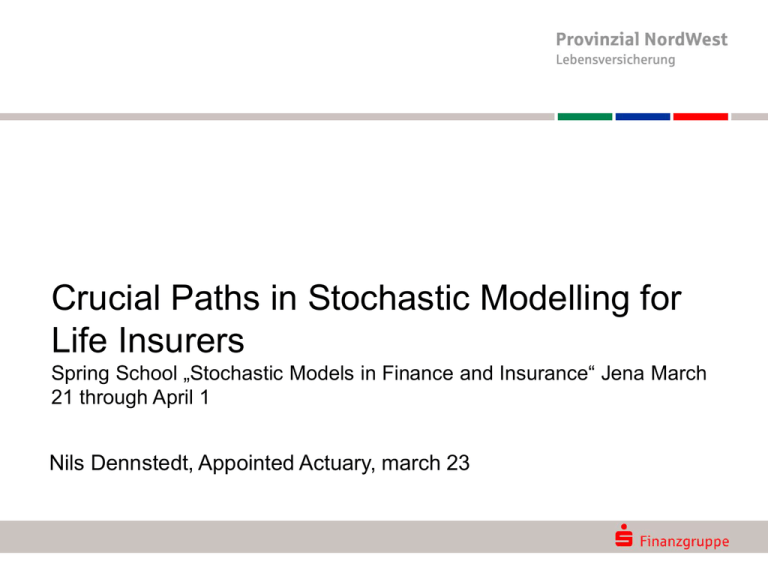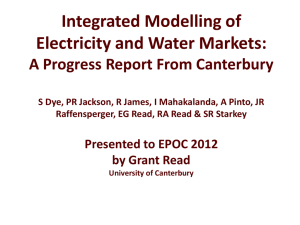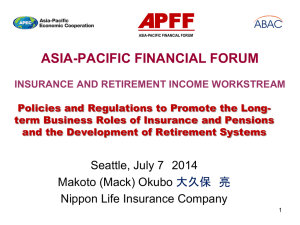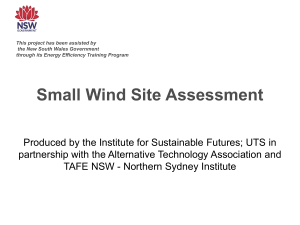
Crucial Paths in Stochastic Modelling for
Life Insurers
Spring School „Stochastic Models in Finance and Insurance“ Jena March
21 through April 1
Nils Dennstedt, Appointed Actuary, march 23
Agenda
What is the Matter?
Big Deal!
What is the Complexity?
What is the Risk?
The Volatility Glare
Crucial Paths in Stochastic Modelling for Life Insurers – Spring School Jena 2011 /page 2
Agenda
What is the Matter?
Solvency II – Quick Overview
Big Deal!
Simple Approach on Pricing Models
Risk Neutral Valuation
What is the Complexity?
A Typical Insurance Product
What is the Risk?
Key Risk Drivers
The Choice of Risk Measure
The Volatility Glare
Steering Mechanisms in Life Insurers
Crucial Paths in Stochastic Modelling for Life Insurers – Spring School Jena 2011 /page 3
Agenda
What is the Matter?
Big Deal!
What is the Complexity?
What is the Risk?
The Volatility Glare
Crucial Paths in Stochastic Modelling for Life Insurers – Spring School Jena 2011 /page 4
Economic Balance Sheet in QIS5
Own Funds (Net Asset Value):
equity capital
Available
Solvency
Margin / own
funds
present value future earnings
German specialty: going-concernreserve
Liabilities:
riskmargin
cost for options and guarantees
Technical
Provisions
PV of future pol.-holder participation
best estimate pv of guaranteed benefits
deferred taxes
market value other liabilities
Assets:
market value assets
market value other assets
Crucial Paths in Stochastic Modelling for Life Insurers – Spring School Jena 2011 /page 5
Solvency II – Transition to Economic Balance
Sheet - Overview
Economic Balance Sheet
Local GAAP / BEL
EC
PVFP
SH + PH
Market
Value
Assets
ASM
PVFPSh
RM
O&G
PVFPPh
Best
Estimate
Guaranteed
Benefits
Techn.
Provision
RM=Risikmargin, PVFP= Presetn Value of Future Profits, SH = Shareholder, PH = Policyholder, O&G = Time Value of Options and Guarantees,
EC = Economic Capital, ASM = Available Solvency Margin, BEL = Best Estimate Liabilities
Crucial Paths in Stochastic Modelling for Life Insurers – Spring School Jena 2011 /page 6
Evaluation of Solvency Capital Required (SCR)
SCR (Solveny Capital Required):
Required capital due to change of economic capital under stress
change in
economic
capial
=
Net-SCR
Economic
capital
Market
value of
assets
Market value
of insurance
liabilities
Stress
Marktwert
KA
example: interest rates down (due to higher duration of liabilities market value of liabilities
grows more than market value of fixed income assets)
Crucial Paths in Stochastic Modelling for Life Insurers – Spring School Jena 2011 /page 7
Derivation of Solvency Ratio
1
Obtain Own Funds from Economic Balance Sheet
Own Funds
2
Evaluation of required capital on given safety level for different risk types
Market Risks
Underwriting Risks
Market
value
assets
Market
value
Liabilities
Operational Risks
Default Risks
Intangibles
Assets
Liabilities
3
Solvency Ratio: Available Capital over Required Capital
Crucial Paths in Stochastic Modelling for Life Insurers – Spring School Jena 2011 /page 8
Required Capital
Standard Formula Concept
How to Obtain the Solvency Capital Required (SCR)
After Risk Mitigation and OpöRisk
2. Level of Aggregation
1. Level of Aggregation
Source: QIS 5 Technical Specifications, p. 90
Crucial Paths in Stochastic Modelling for Life Insurers – Spring School Jena 2011 /page 9
Standard Formula with Modular Approach
Obtaining each Required Capital per Risk
Economic
Capital
Market
Value
Assets
•
Required capital equals change of economic capital in stress scenario
•
Required Capital is determined on a defined safety level on a one year horizon
•
Safety level for 1-year-VaR equals 99,5%.
Market
Value
Liabilities
Probability
SCR = ∆ Economic Capital
0.5%
Crucial Paths in Stochastic Modelling for Life Insurers – Spring School Jena 2011 /page 10
Expected
Value
Market Risks - Overview
Interest rate risk
Equity risk
Property risk
Spread risk
Concentration risk
Currency risk
Illiquidity premium risk
interest rates up / down scenario
Market value reduction of 30% for
„equities global“ and 40% for „other“
market value reduction of 25%
split of spread risk in five submodules
capital requirement depends on
rating and duration
Aggregation to
market risk
concentration Rrsk derived based
on threshold and rating classes
± 25% change in value of asset and liability
in foreign currency
Reduction of observable market
illiquidity premium by 65%
Crucial Paths in Stochastic Modelling for Life Insurers – Spring School Jena 2011 /page 11
vereinfachte Darstellung
Underwriting Risks - Overview
mortality
permanent increase of moartality rates by 15%
for policies with mortality risk
longevity
permanent decrease of moartality rates by 20%
for policies with longevity risk
disability
lapse
cost
catastrophy
revision
permanent increase of disability rates by 25%;
first year by 35%
additional reduction of reactivation rates. by 20%
max over mass lapse in first year of projection,
increase of lapse rates by 50%,
decrease of lapse rates by 50%
Aggregation to
life
underwriting
risk
permanent increase of costs by 10%;
absolute increase in inflation by 1%
absolute increase of mortality rates in first year of
projection by 1,5‰ for policies with mortality risk
irrelevant in Germany
Crucial Paths in Stochastic Modelling for Life Insurers – Spring School Jena 2011 /page 12
vereinfachte Darstellung
Risk Categories - Overview
Market
Default
Aggregation of market risks by covariance matrix. The matrix is depends on whether
interest rate up or interest rate down is the key risk in the interest rate category.
Die Kapitalanforderung für das Gegenparteiausfallrisiko hängt von Typ und Rating der
Forderung ab.
aggregation
to
BSCR
Life
Aggregation of Life Underwriting Risks by covariance matrix.
Intang
For intangible assets a loss in value of 80% is assumed.
Crucial Paths in Stochastic Modelling for Life Insurers – Spring School Jena 2011 /page 13
Agenda
What is the Matter?
Big Deal!
What is the Complexity?
What is the Risk?
The Volatility Glare
Crucial Paths in Stochastic Modelling for Life Insurers – Spring School Jena 2011 /page 14
Risk neutral measures vs. real world
explained by a bookmaker
Price: 10 € per bet placement.
Who wins?
Bookmaker sets risk neutral rates.
1,5 3,0
rates get set according to incoming bets. Brazil gets twice the votes
since clear favorite.
Bookmaker calculates:
2.000 x 10 € x 1,5 = 30.000 €
1.000 x 10 € x 3,0 = 30.000 €
Bookmaker is free of risk, so no dependancy on turnout and the real probability of Brazil to win
Risk neutral probabilities are (derived from rates and thus equal to
market prices):
Brazil: 2/3, England 1/3
Crucial Paths in Stochastic Modelling for Life Insurers – Spring School Jena 2011 /page 15
What do customers (fans) think in real life?
Fan checks available information and weighs subjectively
strengths home / guest
current trends
injured players
etc.
Say, (subjective) real world probability turns out to be ¾, thus more
than expected by bet rates.
■ Investment seems attractive
■ but there is risk: (brazil can still loose)
Crucial Paths in Stochastic Modelling for Life Insurers – Spring School Jena 2011 /page 16
The problem of arbitrage…
What is a fair price of a call option?
Z(T ) max S(T ) K;0 at time T 1
with Strike K 2
The underlying can reach two values with probabilities
1
1
P ( A )
and P (B )
,
2
2
S(0) : 2
S(1; A) : 4
S(1; B):1
According to game theory, the fair price amounts to
Z (0) EP Z (1) 2
1
1
0 1
2
2
Crucial Paths in Stochastic Modelling for Life Insurers – Spring School Jena 2011 /page 17
leads to martingales!
A financial investor can also invest directly into the underlying which
leads to risk neutral pricing.
□ A risk neutral fair price is the value of the replicating portfolio
□ The game theoretical fair price leads to arbitrage
□ Risk neutral fair prices can be seen as expected value of option
payout under the equivalent martingale
Portfolio: Invest in Cash and Underlying
V H (0) : H0 H1S(0)
V H 1, : H0 H1S1,
Replication of option payout: find strategy so that
H0 H1
V H 1, Z 1,
!
0
H0 4H1 2
Value of replicating portofolio at time 0 is fair price:
Z (0) : V H (0)
2 2
2
2
3 3
3
Crucial Paths in Stochastic Modelling for Life Insurers – Spring School Jena 2011 /page 18
2
2
H0 ; H1
3
3
If price differs from risk neutral price
you got arbitrage!
■ Market price < risk neutral price
□ Buy option
□ Sell replicating portfolio for risk neutral option price
■ Market price > risk neutral price (opposite way around!)
Martingale constraint can be derived!
(1)
Q 1
(2) Risk neutral price equals game theoretical price
V H 0 EQ V H 1 S0 EQ S1
■ For the example this leads to
QA QB
1
4QA QB 2
QA
1
2
; QB
3
3
Crucial Paths in Stochastic Modelling for Life Insurers – Spring School Jena 2011 /page 19
Replicating portfolio is martingale according
to equivalent martingalemeasure Q.
Fair price can be calculated without knowing
explicit trading strategy!
What makes martingale measure unique?
■ Harrison-Pliska
□ No arbitrage implies existence of martingale measure
■ Completeness-Theorem
□ (For each derivative a replicating portfolio exists)
□ Assumption (no arbitrage)
□ Market model is complete
measure is unique
equivalent martingale
■ Next steps
□ Cox-Ross-Rubinstein, Cox-Ingerson-Ross, Itô, Feynman-Kacformula, Black-Scholes
Crucial Paths in Stochastic Modelling for Life Insurers – Spring School Jena 2011 /page 20
Risk neutral scenarios vs. deflators
You can use real world scenarios for pricing if you apply stochastic deflators
e.g., risk free rate set to 5%, equity can have two states after one year
q=½
150
100
90
q=¼
150
100
p=½
90
D1=10/21
q=½
100
p=¾
90
risk neutral: transformation of
probabilities
D2=30/21
discounting by stochastic
deflators
Deflators contain information on probability transformation explicitly
■ pro: Same scenario set can be used for pricing and risk assessment
■ con:
□ numerically less stable
□ generating deflators is a complex matter
Crucial Paths in Stochastic Modelling for Life Insurers – Spring School Jena 2011 /page 21
p=½
150
No matter what – two scenario sets are needed
Pricing:
risk neutral environment
Risk assessment / investment:
real world environment
Alternatively, evaluation of financial guarantees might work through a closed formula approach:
policyholder can „switch“ assets, namely value of guaranteed benefit (A) versus asset value (B = A +
future bonuses) [Margrabe-Option]
WBA SA N z1 SB N z2
S 1
ln A 2 t
S
2
z1 B
t
,
with
z2 z1 t
A2 B2 2 AB A B
difficulty here: finding the „right“ volatilities
Crucial Paths in Stochastic Modelling for Life Insurers – Spring School Jena 2011 /page 22
Agenda
What is the Matter?
Big Deal!
What is the Complexity?
What is the Risk?
The Volatility Glare
Crucial Paths in Stochastic Modelling for Life Insurers – Spring School Jena 2011 /page 23
Life Insurance is a Complex Business
long term contracts
P&L statement does not show
Lifetime annuity up to 70 years
profitability of life insurance business
Embedded Value
Evaluate value of undertaking by future profits and losses
Analysis of undertaking’s profitability
Steering by (Market Consistent) Embedded Value
Crucial Paths in Stochastic Modelling for Life Insurers – Spring School Jena 2011 /page 24
Liabilities can be of any complexity
floor + floater
examples of options and guarantees in life insurance
guarantees
Policyholder options
Counteroptions insurer
■ Guaranteed rate
□ Guaranteed over entire
term
□ Has to be earned by
undertaking on financial
market
■ lapse
□ Policyholders can
withdraw contract at any
time
□ Possible realisation of
hidden losses
■ Discretionary benefits
□ reversionary bonus raises
guarantee
□ Terminal bonus not
guaranteed
predictability
■ Guarantee
of premiumsof
cashflows
□ annuities:
death benefit is
paid up premiums.
□ Due to acquisition cost not
available in the beginning
■ Lump sum option
□ annuities: lump sum
payment instead of life
time annuity payment
□ Possible realisation of
hidden losses
■ Change in risk exposure of
asstes (e.g. equity or real
estate ratio, corporates vs.
Financials, etc.)
Crucial Paths in Stochastic Modelling for Life Insurers – Spring School Jena 2011 /page 25
uncertain cash out
Model undertaking and guide it through 1,000 –
10,000 scenarios
assets
start of projection
prices
market
model
asset
model
and
rates
liabilities
sh equity
assets
net asset return
technical
provisions
mgmt
model
total return
asset allocation
cash flows
liabilities
sh equity
assets
technical
provisions
end of projection
local gaap and p&l
Crucial Paths in Stochastic Modelling for Life Insurers – Spring School Jena 2011 /page 26
liability
model
Modelling needs a ton of information
asset manager
actuary
■ cash flow modelling
■ cash flow modelling
■ asset classes
■ products
□ type
□ Line of business
□ region
□ tariff
□ structure
□ Age / sex
□ maturity
□ Term structure
□ direct investments
□ private / pension scheme
Court of Justice EU
■ reference indices
■ mapping of unmodeled products
■ fungibility
■ policy holder behavior
■ distribution on classes
■ bonus participation rules
■ rebalancing
■ solvency ratio
■ economic evaluation
■ liability reserves („RfB“, „estate“)
■ accounting environment
■ accounting environment
■ hidden reserves
■ profit sources
Crucial Paths in Stochastic Modelling for Life Insurers – Spring School Jena 2011 /page 27
EIOPA
Some product parameters
Parameters for technical provisions and
pricing
additional forecast parameters
■ guaranteed rate
■ net asset return per scenario
■ mortality tables
■ observed mortality
■ occupational disability and other tables
■ observed other termination rates
■ cost parameters (which reference, which
rate,…)
■ realistic costs
■ discretionary bonus parameters (which
scheme, which reference, which rate,
reversionary / discretionary,…)
■ policholder lapse behavior
■ lump sum pick up rates
■ Payment exemption rates
■ Indexation cancellation rates
■ …
Crucial Paths in Stochastic Modelling for Life Insurers – Spring School Jena 2011 /page 28
Do undertakings know their specific
parameters?
lump sum pick up in 2035?
lapse behavior with 10y gov‘t at 7,5%
and total return policyholder at 4,9%?
life expectancy of a 65-year-old in
2045?
indexation: termination rate in 2025?
social security retirement age at 2030?
Crucial Paths in Stochastic Modelling for Life Insurers – Spring School Jena 2011 /page 29
Which quality level of answers does a model produce?
data storage
findings
undertakings software
needs to store historic data
relative comparisons
valuable
quality of cahs flows
stochastic simulations?
volatility of results
Steering possibilities
risk exposure
Crucial Paths in Stochastic Modelling for Life Insurers – Spring School Jena 2011 /page 30
Deep and liquid markets – dispelling the myths
long term EUR-market shows vacancies…
200.000
90% 95%
180.000
160.000
98%
99%
174
179
Euro market
150
Outstanding Amount (millions)
139
140.000
120.000
100.000
100
90
80.000
79
60.000
53
49
40.000
19
16 9 13
6 614
7
12 1
1 13 2
20.000 20
0
1
3
5
Source: Barrie & Hibbert
7
1
1
31
2
9 11 13 15 17 19 21 23 25 27 29 31 33 35 37 39 41 43 45 47 49 51 53 55 57 59 61 63 65 67 69 71 73 75 77 79 81 83 85 87 89 91 93 95
time to maturity in years
Labels denote number of bonds
Crucial Paths in Stochastic Modelling for Life Insurers – Spring School Jena 2011 /page 31
Deep and liquid markets – dispelling the myths
different market – different deepness
25.000
98%
90% 95%
99%
GBP market,
amounts denoted
in EUR
45
43
20.000
Outstanding Amount (millions)
43
35
33
15.000
39
23
28
29
24 25
21
20
10.000
18
22
23
98
14
5.000
11 9
13 10
10
58
6
10
4
6
4
4
2
2
1
1
11
1
0
1
3
5
7
Source: Barrie & Hibbert
9 11 13 15 17 19 21 23 25 27 29 31 33 35 37 39 41 43 45 47 49 51 53 55 57 59 61 63 65 67 69 71 73 75 77 79 81 83 85 87 89 91 93 95
time to maturity in years
Labels denote number of bonds
Crucial Paths in Stochastic Modelling for Life Insurers – Spring School Jena 2011 /page 32
Non liquid markets present
significant (model) risk
A solvency model which relies significantly on singular data outside a deep
and liquid market horizon in order to determine technical provisions is deemed
to produce (high) model errors
□ For the undertaking itself with long term liabilitites
□ For the supervisor of undertakings with long term liabilities
□ For markets also!
– Strong impact on market prices in nonliquid segment due to
minor changes in demand
– Possible increase in demand due to supervisory regime (and
thus self-energizing!)
– Change in demand by explicit speculation against undertaking
with long term liabilities
Crucial Paths in Stochastic Modelling for Life Insurers – Spring School Jena 2011 /page 33
Influence of mandatory option hedge
in danish market on € fixed income market
■ Danish Supervisor introduces new stress test / solvency system in 2001
Swaption volatility exploded due to sudden demand by Danish life
insurance industry
For the same reason flattening of €-yield curve (falling forward rates)
Danish hedge
(mandatory)
Crucial Paths in Stochastic Modelling for Life Insurers – Spring School Jena 2011 /page 34
Agenda
What is the Matter?
Big Deal!
What is the Complexity?
What is the Risk?
The Volatility Glare
Crucial Paths in Stochastic Modelling for Life Insurers – Spring School Jena 2011 /page 35
Shareholders take a simple point of view
risk is change of undertaking‘s embedded value
What are key drivers of
risk?
Insurer A
Insurer B
How sensitive is the
MCEV*?
Which scenarios are
hazardous?
Value Added Analysis
Sensitivity Analysis
Aggregation of sub risks?
mean
50% of all values in this area
90% of all values in this area
98% of all values in this area
RoE spells RARoRAC nowadays!
Crucial Paths in Stochastic Modelling for Life Insurers – Spring School Jena 2011 /page 36
*MCEV: Market Consistent Embedded
Value
What do you really want to know?
■ one quantile?
■ the expected loss on one quantile?
■ the loss distribution?
Probability
Expected
Value
0.5%
Crucial Paths in Stochastic Modelling for Life Insurers – Spring School Jena 2011 /page 37
What is „the right“ risk measure?
VaR
TVaR / CTE
stresstests
Depends!
Certain characteristics are important, c.f. David Blake, „After VaR“
Coherent risk measures:
monotonicity:
subadditivity:
V Y V X X Y
X Y X Y
hX h X h 0
translational invariance: X n X n
positive homogeneity:
Crucial Paths in Stochastic Modelling for Life Insurers – Spring School Jena 2011 /page 38
for some certain amount n
Agenda
What is the Matter?
Big Deal!
What is the Complexity?
What is the Risk?
The Volatility Glare
Crucial Paths in Stochastic Modelling for Life Insurers – Spring School Jena 2011 /page 39
Tails are of interest for a life insurer
Few scenarios render extraordinary profits and the same goes for losses
V erteilu n disitribution
g PVFPs
Illustrative
of PVFPs*
3000000000,00
3,000 Mio.
2000000000,00
2,000 Mio.
1000000000,00
1,000
Mio.
0
2004
0,00
1
44
87
130
173
216
259
302
345
388
431
474
-1000000000,00
-1,000
Mio.
-2.000
Mio.
-2000000000,00
-3,000
Mio.
-3000000000,00
*PVFP: present value of future profits
Crucial Paths in Stochastic Modelling for Life Insurers – Spring School Jena 2011 /page 40
517
560
603
646
689
732
775
818
861
904
947
990
2005
Duration and Convexity measure price
sensitivity of bonds
■ Duration: linear approximation of change in price
■ Convexity: quadratic approximation of change in price
Current
yield
Interest rates down
Interest rates up
Source: J. Willing, MunichRe
Crucial Paths in Stochastic Modelling for Life Insurers – Spring School Jena 2011 /page 41
The volatility glare: asset-liability position looses
value for both up and down change of interest
rates
A/L position =
asset - liability
Negative convexity needs risk management attention
Source: J. Willing, MunichRe
Crucial Paths in Stochastic Modelling for Life Insurers – Spring School Jena 2011 /page 42
Reduce risk without eliminating franchise value
Receiver swaptions reduce risk
Reduced
guarantee risk
Policyholder
protected
liabilities
Reduced bonus
participation
Shareholders
interest rate risk
Raising
franchise value
assets
discretionary
benefits
but as an option change risk-return profile of asset-liability position
Crucial Paths in Stochastic Modelling for Life Insurers – Spring School Jena 2011 /page 43
What‘s in the takeaway box?
■ Definitely crucial paths for life insurers
detected
■ Long term complex path dependant
liabilities not easily replicated by financial
instruments
■ Complex parameter structure might not be
easy to set and to monitor
■ Deep and liquid markets might not always
exist
■ Market wide alignment of risk strategies can
severely impact markets
■ Life insurance products might change
■ Stochastic modelling bears some risk
Crucial Paths in Stochastic Modelling for Life Insurers – Spring School Jena 2011 /page 44






